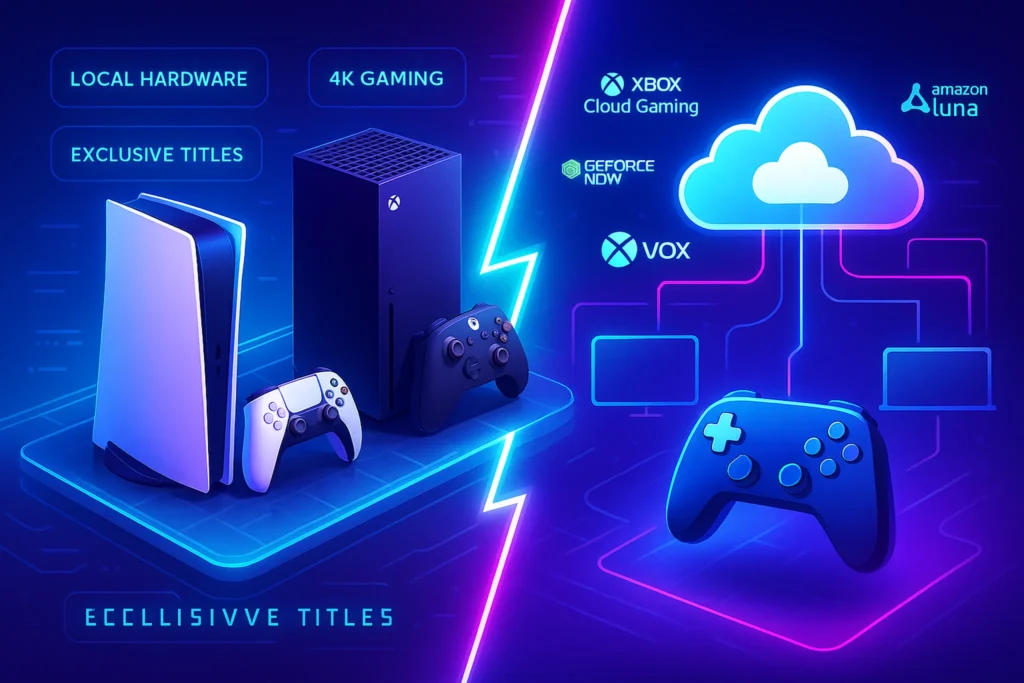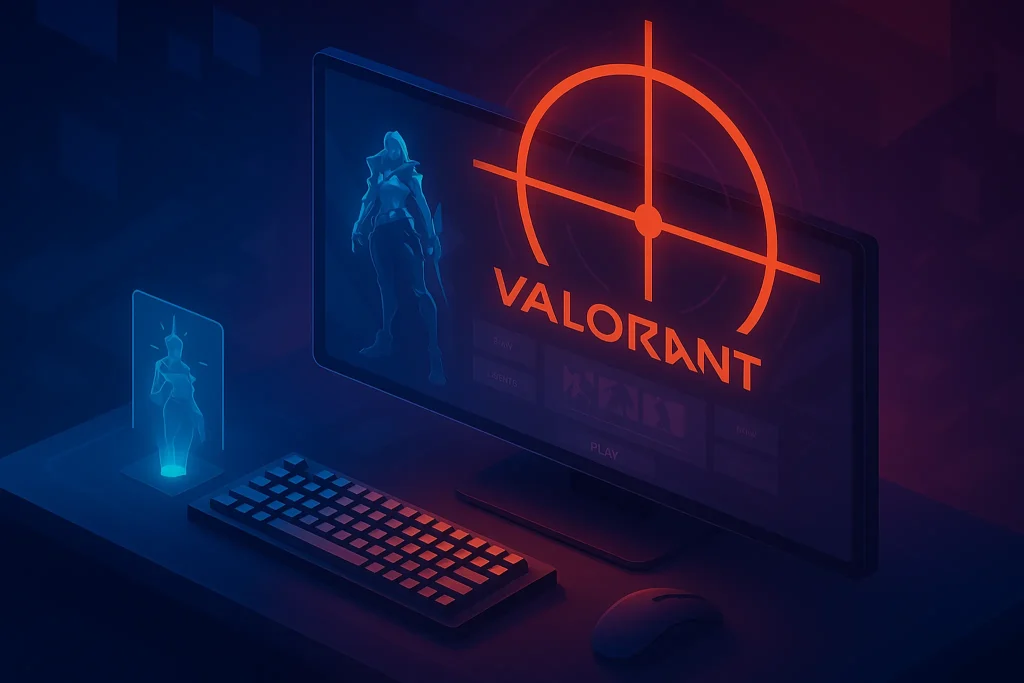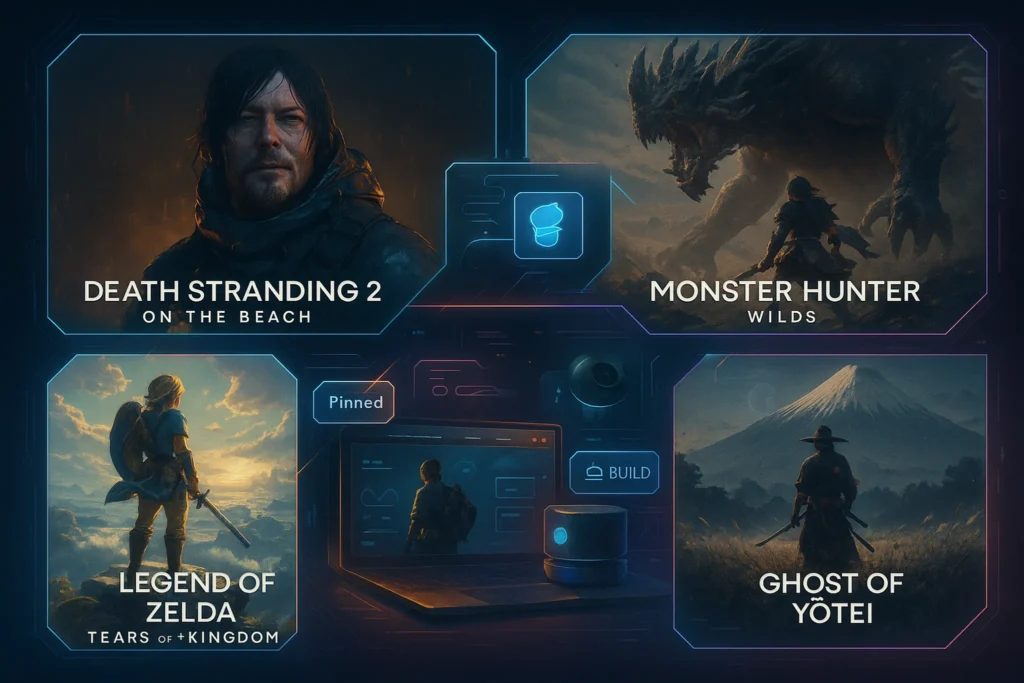-This post may contain affiliate links. If you click on one and make a purchase, I may earn a small commission at no extra cost to you.-
🎮 Introduction: Are We Witnessing the End of Consoles?
There was a time when gaming meant one thing: a console, a couch, and a disc (or cartridge). But those days are fading fast.
With the rise of platforms like Xbox Cloud Gaming, GeForce NOW, and Amazon Luna, you can now stream high-quality games directly from the cloud without owning a single piece of powerful hardware.
Sounds like magic? Maybe. But it’s real—and it’s changing everything.
Yet, the question remains:
Will consoles truly become obsolete? Or will they evolve into hybrid machines coexisting with cloud-based services?
Remember the old days when every few years a new console generation would change everything?
We went from pixelated 8-bit worlds to jaw-dropping ray-traced realism—thanks to physical consoles like the NES, PlayStation, and Xbox. These machines were powerhouses, each generation more powerful than the last.
But now?
The trend is shifting away from owning powerful hardware toward accessing power remotely.
Cloud gaming promises a future where:
-
You don’t need a console or gaming PC
-
You can jump into any game instantly
-
You can play anywhere: on your TV, phone, laptop—even your fridge (okay, maybe not yet)
It’s a massive paradigm shift. One that threatens the traditional console business model—especially as subscription-based services like Xbox Game Pass dominate the headlines.
But is the console era truly ending—or simply evolving into its next form?
While we’re on the topic, don’t miss our PlayStation 5 vs. Xbox Series X to see how the current generation stacks up.
Let’s break it down.
☁️ What Is Cloud Gaming?
Cloud gaming is the practice of playing games that run on powerful remote servers—not on your local device.
Here’s what makes it revolutionary:
-
-
No console or high-end PC required
-
-
All rendering and computation happen on cloud servers
-
You just need a stable internet connection and a device with a screen
-
Unlike simple “remote play,” cloud gaming doesn’t need your own console to be running
It’s the Netflix of gaming, but with real-time input, responsive gameplay, and wide device support. The experience, however, heavily depends on internet speed and latency.
Also check out our curated list of Top 10 Indie Games—many of which are already playable on cloud platforms!
🔧 Major Cloud Gaming Platforms Compared
🧠 Speed, Games, Devices & Price
| Platform | Latency | Game Library | Ecosystem Fit | Pricing Model | Best For |
|---|---|---|---|---|---|
| Xbox Cloud | ✅ Low (30–50ms avg) | 100+ Game Pass titles | Windows, Xbox, Mobile | Bundled with Game Pass Ultimate | Console fans, new players |
| GeForce NOW | ⚡ Ultra-fast (20–35ms) | Bring-your-own Steam/Epic | PC-centric, Cloud-only | Free, Priority, Ultimate tiers | Hardcore/PC gamers |
| Amazon Luna | 🟡 Moderate (~60ms) | Channels (Ubisoft, Jackbox) | Alexa, FireTV, Luna controller | Family-friendly plans | Casual, family setups |
| PlayStation Plus Cloud | 🔄 Limited (~80ms) | PS exclusives (older gens) | Tied to PS5/PS4 | Part of PS+ Premium | Nostalgia, exclusives |
🧠 Key Observations:
-
GeForce NOW is unmatched in latency and supports high-end features like 120fps and RTX—but only if your Steam library is rich.
-
Xbox Cloud is the best all-rounder, offering a massive curated library across PC, console, and mobile with minimal friction.
-
Luna is the underdog, offering plug-and-play simplicity for families, but lacks AAA depth.
-
PlayStation’s cloud offering feels more like a side-feature than a full service—especially with its limited device support and lack of day-one titles.
Each has strengths and gaps. Xbox Cloud shines with Game Pass. GeForce NOW leads in performance for existing Steam users. Luna is affordable and family-friendly. Sony, while late to the party, still holds key exclusives.
🎮 Real-World Use Cases for Cloud Gaming
Cloud gaming isn’t a one-size-fits-all solution. Different types of gamers benefit differently based on how, when, and where they play.
✅ Casual Gamers on the Go
Perfect for those who play occasionally and don’t want to invest in expensive hardware.
Example: You’re on your iPad during a commute and suddenly want to jump into Fortnite or Forza Horizon. Just connect to Xbox Cloud Gaming, pair your controller, and go.
No downloads. No waiting.
👨💼 Reza – Busy Professional (Casual Gamer)
-
Setup: Laptop + Controller
-
Use Case: 15–30 min gaming sessions during lunch break
-
Platform: Xbox Cloud via browser
-
Experience: Seamless. He finishes Hi-Fi Rush and Doom Eternal without installing anything.
“As a dad of two, I love that I can jump into a game while waiting for a Zoom meeting.”
🎮 Sarah – Competitive Gamer & Streamer
-
Setup: Desktop + Fiber Internet
-
Use Case: Ranked Apex Legends matches
-
Platform: Tried GeForce NOW
-
Experience: Occasionally smooth, but inconsistent for split-second reactions. Switched back to local install.
“No cloud service can match local precision yet—not for high-skill matches.”
🌍 Leon – Digital Nomad
-
Setup: Chromebook + GeForce NOW
-
Use Case: Traveling through Southeast Asia
-
Platform: Plays Cyberpunk 2077 in cafes
-
Experience: Surprisingly solid using wired hotel Ethernet or local SIM with 5G
“It’s wild to play AAA games from a $300 laptop while sipping coconut water in Bali.”
🎮 Hardcore Gamers & Competitive Players
This is where things get tricky.
While cloud platforms promise low latency, competitive gaming still depends heavily on milliseconds. Input lag, FPS stability, and latency spikes can ruin the experience.
Cloud gaming is getting better—but local hardware still rules in eSports and high-stakes PvP.
🧳 Digital Nomads & Frequent Travelers
No console? No problem.
Cloud gaming on Steam Deck, Chromebooks, or even mid-range laptops lets you access your entire game library from anywhere.
Perfect for long-term travelers, students abroad, or anyone who moves frequently but still wants to game.
🧠 Pros and Cons of Cloud Gaming
✅ Pros:
-
No expensive console or GPU needed
-
Play instantly – no downloads or updates
-
Cross-platform support – play on mobile, laptop, or TV
-
Expanding game libraries (especially with Game Pass)
❌ Cons:
-
Internet-dependent – latency and dropouts kill the experience
-
Not ideal for competitive gameplay
-
Visual artifacts on weak connections
-
Subscription fatigue – multiple platforms = multiple fees
Cloud gaming is amazing—when it works well. But if your internet isn’t rock solid, the experience may frustrate more than delight.
🕹️ Are Consoles Dying?
Console sales have started to plateau globally. However, that doesn’t necessarily mean the death of the console.
Sony and Microsoft are heavily investing in cloud infrastructure while still designing their next-generation consoles. Why? Because hybrid solutions may be the future.
Imagine a PS6 that acts both as a local powerhouse and a cloud-streaming gateway. Or an Xbox that offers native + cloud gaming out-of-the-box.
Just like DVDs didn’t kill theaters, cloud gaming may not kill consoles—it may redefine them.
So no, consoles aren’t dead yet. But they won’t survive unchanged.
🧠 Nerd Verdict: Should You Invest in Cloud Gaming Now?
If you’re a casual gamer, frequent traveler, or just someone with a decent internet connection and no interest in buying a $600 console, cloud gaming is already a viable option.
Services like Game Pass Ultimate and GeForce NOW are mature enough for a smooth experience in most genres—especially single-player, strategy, or adventure games.
However, if you:
-
Play competitive FPS games
-
Live in an area with weak internet
-
Prefer local reliability and ultra-high framerates
… then traditional consoles (or gaming PCs) are still your best bet—for now.
⚡ Nerd Verdict: Cloud gaming is no longer a gimmick. It’s a growing alternative—but not yet a universal replacement.
Consider going hybrid: console at home, cloud on the go.
❓ FAQ
💬 Would You Bite?
🎮 Do you think you’ll still be buying consoles by 2030—or will a controller and a fast internet be all you need?
Drop your predictions in the comments 👇



